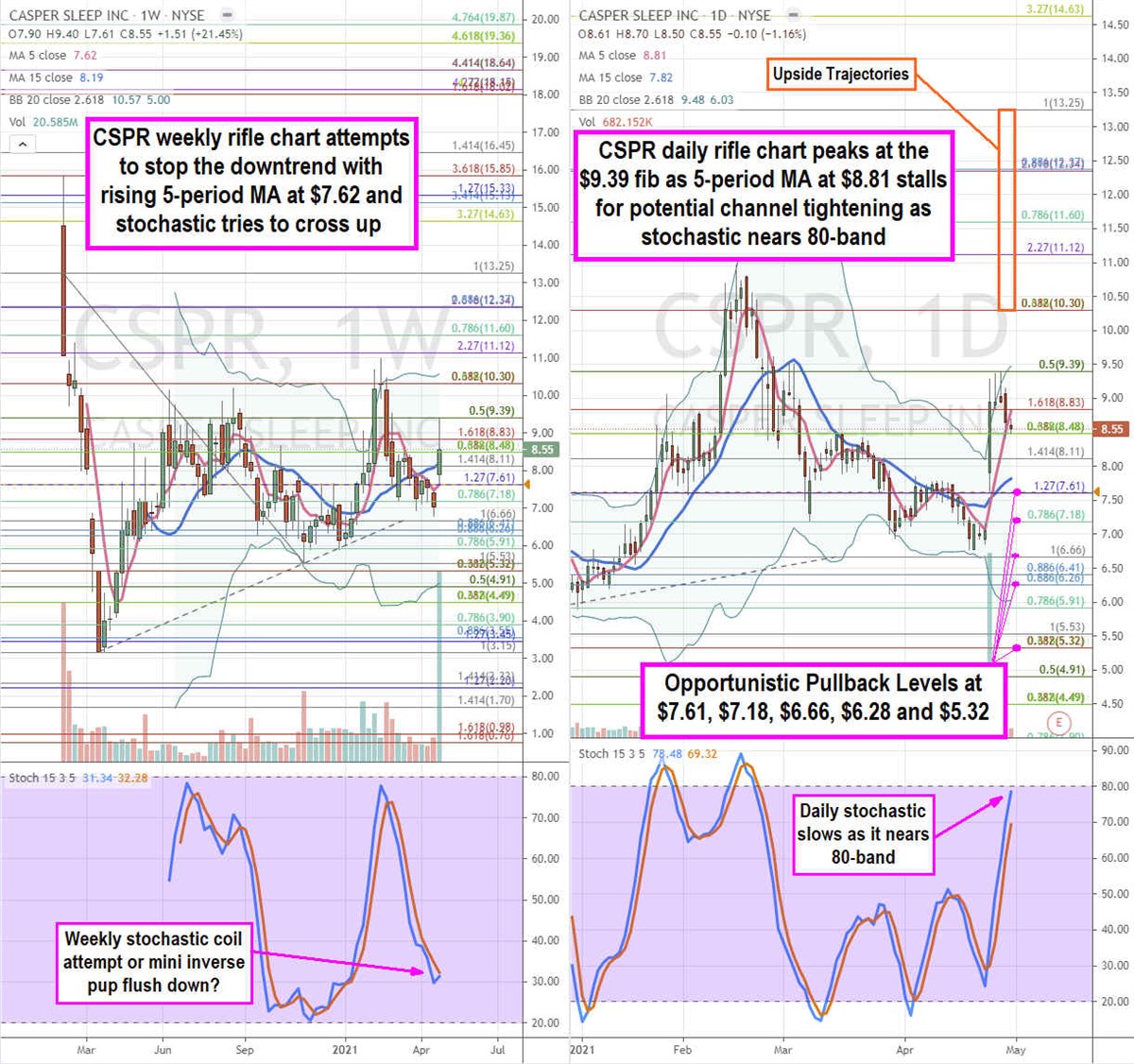Mattress and sleep products maker
Casper Sleep NASDAQ: CSPRstock has been beaten down despite being a
pandemic benefactor, but shares are attempting to stage a comeback. The shortfall in its Q3 2020 earnings was caused by
supply chain issues, not demand which appears to have been improved in its Q4 2020 release. Demand continues to grow as margins improve. The direct-to-consumer (DTC) millennial favored brand broadened its distribution channel partnering with major retailers
Macy’s NYSE: M,
Nordstrom NYSE: JWN,
Target NYSE: TGT among other partners.
Mattress companies have been strong performers until peaking recently as illustrated by the performance of key competitors
Sleep Number NASDAQ: SNBR and
Temper Sealy NYSE: TPX. Casper shares have still vastly underperformed, leaving more room for upside. Consumer
discretionary spending is expected to accelerate thanks to the third round of stimulus checks with the potential for a fourth round. The growing rate of
COVID-19 vaccinations has helped accelerate
re-openings to boost foot traffic at malls and brick-and-mortar retailers. Prudent investors looking for wholesale pricing opportunities in the retail mattress segment that’s popular among the millennial demographic can monitor Casper shares for pullbacks.
Q4 FY fiscal 2020 Earnings Release
On Feb. 24, 2021, Casper released its fourth-quarter fiscal 2020 results for the quarter ending December 2020. The Company reported an earnings-per-share (EPS) loss of (-$0.37) excluding non-recurring items versus consensus analyst estimates for a loss of (-$0.36), a (-$0.01) per share miss. Revenues rose 18.4% year-over-year (YoY) to $150.3 million, beating consensus analyst estimates for $137.87 million.
Lowered Q1 2021 Guidance
Casper expected Q1 2021 revenues between $118 million to $125 million, below the $130 million consensus analyst estimates. The Company expects full-year 2021 revenues between $570 million to $600 million versus analyst expectations for $577.87 million.
Conference Call Takeaways
Casper CEO Philip Krim set the tone, “In the fourth quarter, our North American revenue grew 26%, gross margins were above 50% representing a period-over-period improvement of over 250 basis points, and adjusted EBITDA improved 80% period-over-period.” The Company addressed its supply chain issues in the quarter. The Company benefitted from consumer behavioral changes brought on by the pandemic, including “increased suburbanization and the heightened focus on health and wellness”. The Company plans to drive growth through improving brand awareness, sleep education, expanding product offerings, and bolstering points of distribution.
Product Diversification
The Casper Labs segment is always innovating and creating new products meant to improve sleep and wellness. The Company offers mattresses at differing price points in addition to the introduction of addition sleep products to diversify revenue streams like pillows, sheets, and accessories. “We are particularly pleased with the success of our pillow line with North American pillow revenues up 35% year-over-year in 2020, further highlighting our ability to leverage our brand beyond mattresses. In 2021, you should expect us to continue to help our customers with the introduction of new and innovative products.”, stated CEO Krim. The Company now sells over 40 sleep products.
Partnerships and Distribution Channels
The North American DTC channel grew 19.1% YoY in 2020 and the North American retail partnership channel grew 42.8% YoY. Casper seeks to continue expanding its retail partnership channel which also includes Sam’s Club, Ashley HomeStore, Denver Mattress and Mathis Brothers. Total retail Casper Sleep stores rose to 67 by year-end 2020, with all locations open and operating within traffic guidelines. CMO and President, Emilie Arel summed it up, “2021 will be an exciting year of new products including blankets, throws, pillows, sheets and more all designed to make your bedroom your favorite room in your home and help you get a better night’s sleep. This continue shift from a singular product strategy to a comprehensive focus on sleep and wellness further supports our authority as a sleep destination and provides additional entry points in the brand.”

CSPR Opportunistic Pullback Price Levels
Using the rifle charts on the weekly and daily time frames provides a precision view of the landscape for CSPR stock. The weekly rifle chart uptrend peaked at the $15.85 fib Fibonacci (fib) level post-IPO. Shares have since collapsed as lows at $3.15 before recovering. The weekly rifle chart downtrend was stalled on its recent spike to the $9.39 fib. The weekly 5-period moving average (MA) is sloping up at $7.62 with 15-period MA at $8.19. The weekly stochastic is attempting to cross up off the 30-band, but it could form a bearish mini inverse pup if shares fall back under the weekly 5-period MA. The daily rifle chart formed a market structure low (MSL) buy triggers above $7.17 with an opposing market structure high (MSH) that triggered under $10.03. The daily 5-period MA sits at the $8.83 fib as the stochastic oscillation is reaching the 80-band. Opportunistic pullback levels sit at the $7.61 fib, $7.18 fib, $6.66 fib, $6.28 fib, and the $5.32 fib. Upside trajectories range from the $10.30 fib up towards the $13.25 fib.
Unlock the timeless value of gold with our exclusive 2025 Gold Forecasting Report. Explore why gold remains the ultimate investment for safeguarding wealth against inflation, economic shifts, and global uncertainties. Whether you're planning for future generations or seeking a reliable asset in turbulent times, this report is your essential guide to making informed decisions.
Get This Free Report
Like this article? Share it with a colleague.
Link copied to clipboard.